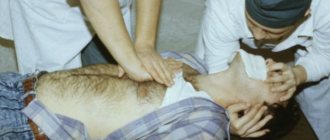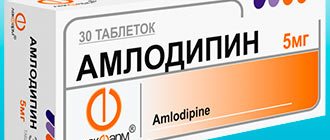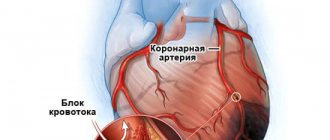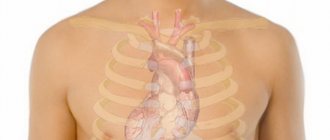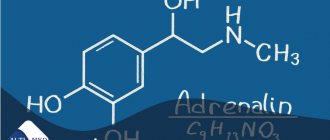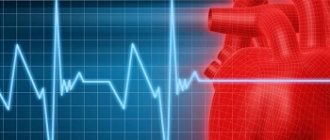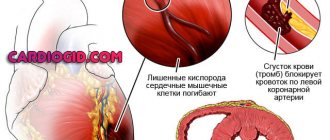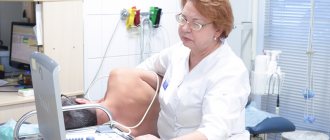Cardiac arrest is a complete cessation of ventricular contractions or severe loss of pumping function. At the same time, electrical potentials disappear in myocardial cells, impulse pathways are blocked, and all types of metabolism are quickly disrupted. The affected heart is unable to push blood into the vessels. Stopping blood circulation poses a threat to human life.
According to WHO statistical studies, 200 thousand people in the world have cardiac arrest in a week. Of these, about 90% die at home or at work before receiving medical attention. This indicates a lack of public awareness of the importance of emergency response training.
The total number of deaths from sudden cardiac arrest is greater than from cancer, fires, road accidents, and AIDS. The problem concerns not only older people, but also people of working age and children. Some of these cases are preventable. Sudden cardiac arrest does not necessarily occur as a consequence of a serious illness. Such a defeat is possible against the background of complete health, in a dream.
Main types of cessation of cardiac activity and mechanisms of their development
The causes of cardiac arrest according to the developmental mechanism are hidden in a sharp violation of its functional abilities, especially excitability, automatism and conductivity. The types of cardiac arrest depend on them. Cardiac activity can stop in two ways:
- asystole (in 5% of patients);
- fibrillation (in 90% of cases).
Asystole is a complete cessation of ventricular contraction in the diastole phase (during relaxation), rarely in systole. An “order” to stop can come to the heart from other organs reflexively, for example, during operations on the gall bladder, stomach, and intestines.
With reflex asystole, the myocardium is not damaged and has fairly good tone.
In this case, the role of the vagus and trigeminal nerves was proven.
Another option is asystole in the background:
- general oxygen deficiency (hypoxia);
- increased carbon dioxide content in the blood;
- shift of acid-base balance towards acidosis;
- altered electrolyte balance (increase in extracellular potassium, decrease in calcium).
These processes taken together negatively affect the properties of the myocardium. The process of depolarization, which is the basis of myocardial contractility, becomes impossible, even if conductivity is not impaired. Myocardial cells lose active myosin, which is necessary to obtain energy in the form of ATP.
With asystole, hypercalcemia is observed in the systole phase.
Cardiac fibrillation is an impaired communication between cardiomyocytes in coordinated actions to ensure overall myocardial contraction. Instead of synchronous work causing systolic contraction and diastole, many separate areas appear that contract on their own.
The contraction frequency reaches 600 per minute and above
In this case, the ejection of blood from the ventricles is affected.
Energy expenditure is significantly higher than normal, and effective reduction does not occur.
If fibrillation affects only the atria, then individual impulses reach the ventricles and blood circulation is maintained at a sufficient level. Attacks of short-term fibrillation can end on their own. But such ventricular tension cannot provide hemodynamics for a long time, energy reserves are depleted and cardiac arrest occurs.
In what cases is a defibrillator used?
The main indication for electrical cardiac defibrillation (EDC) is ventricular fibrillation. This is a variant of arrhythmia in which the ventricles contract in a chaotic and rapid rhythm (250–450 or more contractions per minute). This leads to a sharp decrease in the volume of blood pushed out of the heart and enormous energy consumption in the heart cells.
Fibrillation always occurs suddenly. Lack of effective blood circulation leads to loss of consciousness, and then to clinical (reversible) and biological (irreversible) death.
In absolutely all cases of ventricular fibrillation, defibrillation is used. It is able to restore normal heart rhythm. Under the influence of a powerful and short-term electrical discharge, depolarization (activation) of the heart cells occurs. Then comes a period of refractoriness - immunity to excitability, after which an impulse from the SA node is able to restore normal heart contractions.
EDS is also carried out when:
- ventricular tachycardia with signs of circulatory arrest (absence of pulse in large arteries and loss of consciousness);
- paroxysmal supraventricular tachycardia;
- atrial fibrillation and flutter.
In the last two cases, defibrillation is carried out in synchronized mode and is called synchronized electrical cardioversion. It is a type of treatment for arrhythmias. In this case, impulses are used that act on the myocardium in a strictly defined phase of heart contractions.
Other mechanisms of cardiac arrest
Some scientists insist on identifying electromechanical dissociation as a separate form of cessation of cardiac contractions. In other words, myocardial contractility is preserved, but is not sufficient to ensure the pushing of blood into the vessels.
In this case, there is no pulse and blood pressure, but the following is recorded on the ECG:
- correct contractions with low voltage;
- idioventricular rhythm (from the ventricles);
- loss of activity of the sinus and atrioventricular nodes.
The condition is caused by ineffective electrical activity of the heart.
In addition to hypoxia, impaired electrolyte composition and acidosis, hypovolemia (decreased total blood volume) is important in pathogenesis. Therefore, such signs are more often observed with hypovolemic shock and massive blood loss.
Since the 70s of the last century, the term “obstructive sleep apnea syndrome” has appeared in medicine. Clinically, it was manifested by short-term cessation of breathing and cardiac activity at night. To date, extensive experience has been accumulated in diagnosing this disease. According to the Research Institute of Cardiology, nocturnal bradycardia was found in 68% of patients with respiratory arrest. At the same time, a blood test showed severe oxygen starvation.
The device allows you to record respiratory rate and heart rhythm
The picture of heart damage was expressed:
- in 49% - sinoatrial block and pacemaker arrest;
- in 27% - atrioventricular block;
- in 19% - blockades with atrial fibrillation;
- in 5% - a combination of different forms of bradyarrhythmias.
The duration of cardiac arrest was recorded as more than 3 seconds (other authors indicate 13 seconds).
During the waking period, no patient experienced fainting or any other symptoms.
Researchers believe that the main mechanism of asystole in these cases is a pronounced reflex effect from the respiratory organs, coming through the vagus nerve.
Causes of cardiac arrest
Among the causes, one can distinguish directly cardiac (cardiac) and external (extracardiac).
The main cardiac factors are:
- myocardial ischemia and inflammation;
- acute obstruction of the pulmonary vessels due to thrombosis or embolism;
- cardiomyopathy;
- high blood pressure;
- atherosclerotic cardiosclerosis;
- rhythm and conduction disturbances due to defects;
- development of cardiac tamponade with hydropericardium.
Extracardiac factors include:
- oxygen deficiency (hypoxia) caused by anemia, asphyxia (suffocation, drowning);
- pneumothorax (the appearance of air between the layers of the pleura, unilateral compression of the lung);
- loss of a significant volume of fluid (hypovolemia) due to injury, shock, persistent vomiting and diarrhea;
- metabolic changes with a deviation towards acidosis;
- hypothermia (hypothermia) below 28 degrees;
- acute hypercalcemia;
- severe allergic reactions.
Pneumothorax of the right lung sharply shifts the heart to the left, with a high risk of asystole
Indirect factors that influence the stability of the body’s defenses are important:
- excessive physical stress on the heart;
- elderly age;
- smoking and alcoholism;
- genetic predisposition to rhythm disturbances, changes in electrolyte composition;
- suffered electrical trauma.
A combination of factors significantly increases the risk of cardiac arrest. For example, drinking alcohol in patients with myocardial infarction causes asystole in almost 1/3 of patients.
First aid for a child
A child is not a small adult. This is a completely original organism, the approaches to which are different. Cardiopulmonary resuscitation remains especially relevant for children in the first three years of life. At the same time, you should not give in to panic and act as quickly as possible (after all, you only have five minutes left).
- The child is placed on the table, unswaddled or undressed, and the mouth is freed from foreign objects or impurities.
- Then, with the pads of the second and third fingers of the hand, located on the lower third of the sternum, pressure is applied at a frequency of 120 pushes per minute.
- The thrusts should be gentle, but intense (the sternum moves to the depth of a finger).
- After 15 compressions, take two breaths into the mouth and nose, covered with a napkin.
- In parallel with resuscitation, an ambulance is called.
Negative effects of drugs
Medicines that cause cardiac arrest are used for treatment. In rare cases, deliberate overdose causes death. This must be proven to the judicial and investigative authorities. When prescribing medications, the doctor takes into account the patient’s age, weight, diagnosis, and warns about a possible reaction and the need to see a doctor again or call an ambulance.
Overdose occurs when:
- non-compliance with the regime (taking pills and alcohol);
- deliberately increasing the dose (“I forgot to drink this morning, so I’ll take two at once”);
- combination with traditional methods of treatment (St. John's wort, shepherd's ears, self-prepared tinctures of lily of the valley, foxglove, adonis);
- carrying out general anesthesia against the background of continuous medication use.
The use of St. John's wort herb should be very limited; its potency is comparable to antitumor cytostatics
The most common causes of cardiac arrest are:
- sleeping pills from the group of barbiturates;
- narcotic drugs for pain relief;
- groups of β-blockers for hypertension;
- medicines from the group of phenothiazines prescribed by a psychiatrist as a sedative;
- tablets or drops of cardiac glycosides, which are used to treat arrhythmias and decompensated heart failure.
It is estimated that 2% of asystole cases are drug related.
Only a specialist can determine which medications have the most optimal indications and have the least accumulation and addiction properties. You should not do this on the advice of friends or on your own.
Diagnostic signs of cardiac arrest
Cardiac arrest syndrome includes early signs of clinical death. Since this phase is considered reversible with effective resuscitation measures, every adult should know the symptoms, since a few seconds are allotted for reflection:
- Complete loss of consciousness - the victim does not respond to shouting or braking. It is believed that the brain dies 7 minutes after cardiac arrest. This is an average figure, but the time can vary from two to eleven minutes. The brain is the first to suffer from oxygen deficiency; the cessation of metabolism causes cell death. Therefore, there is no time to speculate on how long the victim’s brain will live. The earlier resuscitation is started, the greater the chance of survival.
- Inability to detect pulsation in the carotid artery - this diagnostic sign depends on the practical experience of others. If it is absent, you can try to listen to heartbeats by placing your ear to your bare chest.
- Impaired breathing - accompanied by rare noisy breaths and intervals of up to two minutes.
- “Before our eyes” there is an increase in the change in skin color from pallor to blueness.
- The pupils dilate after 2 minutes of cessation of blood flow, there is no reaction to light (constriction from a bright beam).
- Manifestation of cramps in individual muscle groups.
If an ambulance arrives at the scene of the incident, then asystole can be confirmed by an electrocardiogram.
The risk group for fibrillation is men, with an average age of 45-75 years.
...A spectacular picture. "Discharge! Another discharge! The doctor's confident hands hold electrodes on the patient's bare chest. The patient is unconscious. And now on the monitor of the resuscitator, instead of a straight line, teeth began to run briskly. The doctor takes off his cap with relief, wiping sweat from his forehead. The return to life has happened, the doctors have defeated death!..
This is how most feature films show the defibrillation process. How does everything happen in life?
What is defibrillation and fibrillation
The prefix “de” (Latin) means cancellation, removal, liquidation. Defibrillation is the process of eliminating ventricular fibrillation of the heart.
Ventricular fibrillation (fibrillation) and flutter are pathological conditions in which effective heart contractions do not occur. It's practically cardiac arrest.
Fibrillation cannot stop spontaneously - only under the influence of electrical defibrillation.
See also: Flame motor.
Let's break it down into ventricles. The heart has its own conduction system, capable of generating and transmitting electrical impulses to all its cells. Due to this, a consistent contraction of the chambers of the heart occurs. The body receives oxygen and releases carbon dioxide and other toxic metabolic products that are excreted through the blood.
See also: BlackGate. You can't run away from yourself
With fibrillation, such coordinated work of cells disappears. Individual muscle fibers contract chaotically.
The heart begins to resemble “vibrating jelly.” It loses its ability to contract.
On the ECG, instead of classical waves, chaotic, irregularly shaped waves with a frequency of 200-500 vibrations per minute are recorded.
Every minute reduces the chance of returning to life by 10%
Essentially, fibrillation is cardiac arrest. It is responsible for up to 90% of sudden cardiac death cases.
Blood circulation stops.
Oxygen stops flowing to organs and tissues, hypoxia (oxygen starvation) develops. Cells switch to the economical anaerobic (oxygen-free) metabolic pathway. But at the same time, many toxic under-oxidized products are formed, and acidosis (acidification) develops. Without blood circulation, toxic waste cannot be removed. Cells die.
Brain cells are the most sensitive to hypoxia.
Emergency medical care must be provided within the first 4-10 minutes. (optimally 4-6 minutes - the time that the cerebral cortex can survive without oxygen without serious consequences). Every minute reduces the chance of returning to life by 10%.
If in the 1st minute 90% of patients can be saved, then by the 10th minute, as a rule, no one survives.
Causes of fibrillation
The first and most basic is myocardial infarction.
See also: Heart attack
Other heart diseases (hypertrophic cardiomyopathy, rhythm disturbances) can also lead to fibrillation; metabolic changes, toxins, drug overdose, electrical shock (accident, lightning strike).
Is it possible to start the “motor” after a “short circuit”. The essence of defibrillation
So, with fibrillation, the coordinated work of heart cells is disrupted, they get out of control and begin to contract chaotically.
However, the electrical activity of cells during fibrillation is preserved.
This distinguishes cardiac fibrillation from asystole (lack of systole, contraction) - complete cardiac arrest. With asystole, a straight line is recorded on the ECG. If timely assistance is not provided, fibrillation progresses to asystole. This is due to the fact that heart cells also suffer from oxygen starvation and toxic waste and die.
Asystole may also be the primary condition (it accounts for about 10% of sudden cardiac deaths).
With asystole, a sudden complete cessation of excitability occurs in the heart, a “short circuit.”
In this case, the prognosis is extremely unfavorable. Asystole, if possible, should be converted to fibrillation. The cells must be electrically active, otherwise it will not be possible to “start the engine”.
Defibrillation is the effect of a low-intensity, but high-voltage current on the heart.
This leads to the suppression of all electrical impulses, the direction of which does not coincide with the direction of the defibrillator current. All pathological foci of excitation are suppressed, leaving only those that provide the total vector of normal cardiac contraction. Effective heart function is restored.
How is defibrillation performed?
The defibrillator consists of two blocks: storage and electrode. In the first, electrical energy is accumulated and converted (the current decreases while the voltage increases). Electrodes are placed on the chest and send an electrical current to the heart. There are single- and multi-channel defibrillators. Single-channel has one electrode, and multi-channel has two.
It is desirable that the defibrillator model include an electrocardiomonitor. It allows you to record ECG outside the discharge.
The patient lies on a flat surface. A spacer is required between the electrodes and the body: for example, electrically conductive gel, wipes moistened with a hypertonic NaCl solution or water. The person providing assistance must not touch the patient’s body or other objects (even the surface on which the person is lying. Electrodes are installed on the right under the collarbone and on the left along the anterior axillary line outward from the apex of the heart (then the electrical strength of the impulse will coincide with the direction of the normal electrical axis of the heart) The discharge is applied sequentially with increasing power: 200 J > 300 J > 360 J.
Basic cardiopulmonary resuscitation. What to do if a person falls and loses consciousness before your eyes
There is no time to wait for an ambulance with a defibrillator to arrive. No more than 10 minutes left. What to do?
Cardiac arrest can be suspected if:
- lack of breathing and pulse (check on the carotid arteries),
- lack of pupil reaction to light,
- blue or gray complexion.
Sound the alarm: someone calls the resuscitation team, and someone starts basic cardiopulmonary resuscitation (CPR): chest compressions and mouth-to-mouth artificial respiration. If one person provides assistance, 2 breaths per 15 heart beats; if there are two, the ratio of blowing to pressing is 1:5.
The essence of CPR: artificial imitation of blood circulation occurs. The lungs “breathe” and the heart “contracts.”
The body suffers less from hypoxia.
The task is to hold out until resuscitators arrive with a defibrillator and a set of medications.
Government programs
The sooner specialized assistance is provided, the better the prognosis for life and its quality. In Europe and the United States, programs have been adopted and are being implemented to equip not only medical institutions and ambulances with automatic defibrillators (AEDs), but also public places: shopping centers, train stations, airports, hotels, concert halls, schools.
An airplane cannot land at US airports without a defibrillator on board.
A defibrillator is required in every public school in New York State. More than 50% of US government agencies are equipped with AEDs.
According to British experts, installing AEDs in public places and training staff to use them effectively will save thousands of lives in the next 10 years. In Hungary, all private doctors have an AED. In Germany, all large enterprises are equipped with AEDs
In 2015, the five-year state program “Cardiology” ended in our country. As part of this program, today almost all medical institutions and ambulances are equipped with the most modern biphasic defibrillators with a maximum power of 360 J, which is recommended by the European Association of Cardiac Arrhythmias.
The state program “People’s Health and Demographic Security of the Republic of Belarus” has been adopted (calculated until 2021), where a separate item includes equipping public places with defibrillators.
No less important than equipping public places with AEDs is the medical literacy of the population. Recognizing cardiac arrest in a timely manner and performing basic CPR is the key to saving more than one human life.
Consequences of defibrillation
Only 30% survive cardiac arrest.
Only 3.5% return to normal life, without serious health consequences!
This is usually due to late provision of assistance, when the brain, heart, kidneys, and liver have already been damaged by ischemia. It is important not just to save life. It is equally important to maintain its quality.
The most sensitive organ to ischemia is the brain. If it is possible to restore cardiac activity only after 7-10 minutes, the patient may experience mental and neurological disorders. Delayed help will lead to profound disability for the victim, who will remain a “vegetable” for the rest of his life.
How to prevent sudden death
See also: IHD. Oxygen was cut off to the heart
Remember, in first place - by a huge margin - among the causes of sudden cardiac death is myocardial infarction. Prevention of cardiac death is the prevention of coronary artery disease and myocardial infarction.
See also: Arterial hypertension
A healthy lifestyle, proper nutrition, cultivation of only healthy habits, drug correction of arterial hypertension.
Our life is in our hands!
Main photo of the article from healthversed.com
What are the consequences of cardiac arrest?
The consequences of circulatory arrest depend on the speed and correctness of emergency care. Long-term oxygen deficiency of organs causes:
- irreversible foci of ischemia in the brain;
- affects the kidneys and liver;
- With vigorous massage in elderly people and children, fractures of the ribs, sternum, and the development of pneumothorax are possible.
The mass of the brain and spinal cord together constitutes only about 3% of the total body mass. And for their full functioning, up to 15% of the total cardiac output is required. Good compensatory capabilities make it possible to preserve the functions of nerve centers when the level of blood circulation decreases to 25% of normal. However, even chest compressions can only maintain 5% of normal blood flow.
Read about the rules of resuscitation measures and possible options in this article.
Consequences from the brain can be:
- partial or complete memory impairment (the patient forgets about the injury itself, but remembers what happened before it);
- blindness is accompanied by irreversible changes in the visual nuclei, vision is rarely restored;
- paroxysmal spasms in the arms and legs, chewing movements;
- different types of hallucinations (auditory, visual).
Statistics show actual revival in 1/3 of cases, but complete restoration of brain and other organ functions occurs only in 3.5% of cases of successful resuscitation
This is due to the delay in assistance in cases of clinical death.
Prevention
Cardiac arrest can be prevented by following the principles of a healthy lifestyle, avoiding factors that affect blood circulation.
A balanced diet, quitting smoking, alcohol, and daily walks are no less important for people with heart disease than taking pills.
Monitoring drug therapy requires remembering a possible overdose and a decrease in heart rate. It is necessary to learn how to determine and count the pulse, depending on this, coordinate the dosage of medications with your doctor.
Unfortunately, the time to provide medical care in case of cardiac arrest is so limited that it is not yet possible to achieve full resuscitation measures in out-of-hospital conditions.
CPR Action Plan
- We pay attention to the safety of the approach to the victim.
- We check the victim's consciousness - no.
- We call an ambulance.
- We examine the oral cavity.
- We check for the presence of heartbeat and breathing - none.
- We perform indirect cardiac massage with artificial ventilation of the lungs until the ambulance arrives or the person regains consciousness (reacts to your actions, coughing, groaning, breathing and heartbeat appear).
security check
We check whether there is a threat from above, below and on the sides - heavy objects that can fall on you, wires, wild animals, slippery floors and many other factors that can not only prevent you from performing resuscitation, but also put your life at risk.
- Carrying out cardiopulmonary resuscitation: the correct algorithm of actions
Consciousness check
The first step is to make sure that the victim is unconscious. To do this, you don’t need to hit him in the face, just grab him by the shoulders and loudly ask him something. Immediately pay attention to the people around you and ask them to assist you in saving the person.
Attention! If the victim feels bad in front of you, then after you are convinced that he is unconscious, you should immediately check the pulse in the carotid artery (more details in the fifth paragraph). In the absence of a pulse (exclusively in the absence of a pulse), you should give the victim a precordial blow.
Calling an ambulance
From a landline number 03, from a cell phone 103 or 112. Read more about how to call an ambulance and talk to the dispatcher correctly.
Inspection of the oral cavity
We examine the oral cavity to determine whether there are foreign objects in it that impede breathing. If there are foreign objects (including vomit, mucus, pieces of food), we clean it with gentle movements of a finger wrapped in gauze or any other fabric. Pay attention to the position of the tongue so that it does not fall into the throat, thereby closing the path for air.


